
Paragraph 175 was a provision of the German Criminal Code from 15 May 1871 to 10 March 1994. It made homosexual acts between males a crime, and in early revisions the provision also criminalized bestiality as well as forms of prostitution and underage sexual abuse. All in all, around 140,000 men were convicted under the law. The law had always been controversial and inspired the first homosexual movement, which called for its repeal.
Lieblingminne und Freundesliebe in der Weltliteratur is an anthology of poetry about homosexuality, compiled by the German artist Elisar von Kupffer (Elisarion). First published in 1900, it is the first effort of its kind in modern times, and while several later works have tried to deliver an updated version of von Kupffer's book, it has proven to be a timeless piece of gay literature.
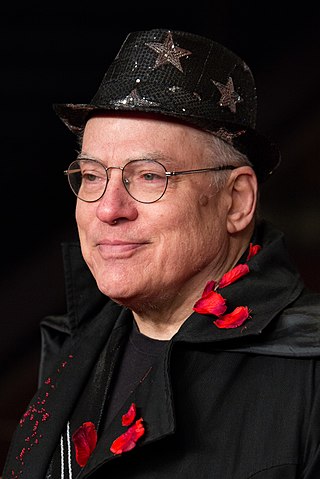
Holger Bernhard Bruno Mischwitzky, known professionally as Rosa von Praunheim, is a German film director, author, painter and one of the most famous gay rights activists in the German-speaking world. In over 50 years, von Praunheim has made more than 150 films. His works influenced the development of LGBTQ+ rights movements worldwide.
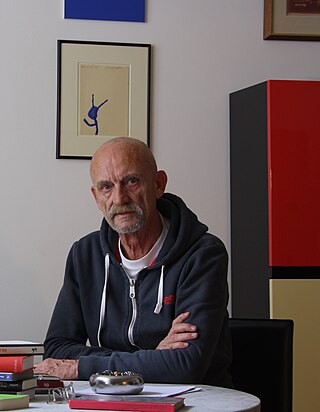
Martin Dannecker is a German sexologist and author.

Heinrich Hössli, sometimes written as Hößli, was a Swiss hatter and author. His book Eros Die Männerliebe der Griechen surveyed references to same-sex love in ancient Greek literature and more recent research, and was one of the first works in the 19th century that defended love between men.
Elmar Kraushaar is a German journalist and author who lives in Berlin.

Rüdiger Lautmann is a German professor of sociology and one of the most prominent LGBT scholars in Germany.

The Memorial to Homosexuals persecuted under Nazism in Berlin was opened on 27 May 2008.

The Frankfurter Engel is a memorial in the city of Frankfurt am Main in southwestern Germany; it is dedicated to homosexual people who were persecuted under Nazi rule, and as well as under Paragraph 175 of the German Criminal Code during the 1950s and 1960s.
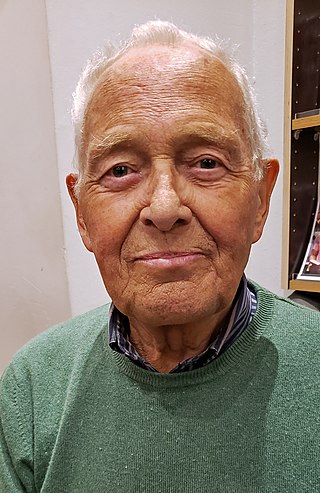
Wolfram Setz is a German historian, editor, translator and essayist.
Centrum Schwule Geschichte e. V., abbreviated CSG, is a German "LGBT" organization based in Cologne (Köln).

The memorial to gay and lesbian victims of National Socialism is a monument in Cologne, Germany, dedicated to the gay and lesbian victims of the Nazis.
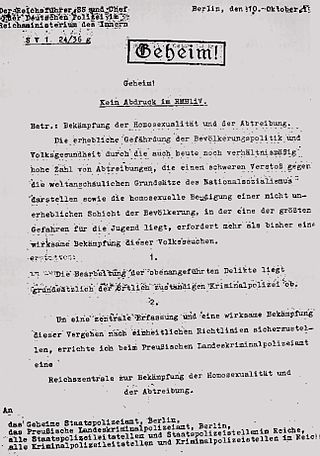
The Reich Central Office for the Combating of Homosexuality and Abortion was the central instrument of Nazi Germany for the fight against homosexuality in Nazi Germany and the fight against abortion.
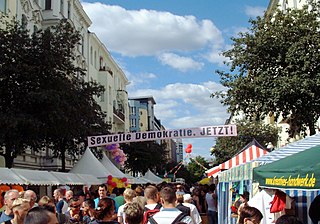
Berlin was the capital city of the German Empire from 1871 to 1945, its eastern part the de facto capital of East Germany from 1949 to 1990, and has been the capital of the unified Federal Republic of Germany since June, 1991. The city has an active LGBT community with a long history. Berlin has many LGBTIQ+ friendly districts, though the borough of Schöneberg is widely viewed both locally and by visitors as Berlin's gayborhood. Particularly the boroughs North-West near Nollendorfplatz identifies as Berlin's "Regenbogenkiez", with a certain concentration of gay bars near and along Motzstraße and Fuggerstraße. Many of the decisive events of what has become known as Germany's second LGBT movement take place in the West Berlin boroughs of Charlottenburg, Schöneberg, and Kreuzberg beginning in 1971 with the formation of the Homosexuelle Aktion Westberlin (HAW). Where as in East Berlin the district of Prenzlauer Berg became synonymous with the East Germany LGBT movement beginning in 1973 with the founding of the HIB. Schöneberg's gayborhood has a lot to offer for locals and tourists alike, and caters to, and is particularly popular with gay men. Berlin's large LGBT events such as the Lesbian and Gay City Festival, East Berlin Leather and Fetish Week, Folsom Europe, and CSD center around Schöneberg, with related events taking place city-wide during these events. Nevertheless, with roughly 180 years of LGBTIQ+ history, and a very large community made up of members with very varied biographies, it is hard to find a place in Berlin completely without LGBT culture past or present. Berlin's present-day neighborhoods with a certain concentration of LGBTIQ+ oriented culture vary somewhat in terms of history, demography, and where the emphasis in each neighborhoods' queer culture falls along the LGBTIQ+ spectrum. Over the course of its nearly two centuries of queer history (herstory), definitions not with standing, Berlin's LGBTIQ+ culture has never ceased to change, not only in appearance and self-understanding, but also in where the centers of queer culture were located in the city. What is true about Berlin's "LGBT culture in Berlin" at one point in time, in a given place and from a given perspective, is almost certainly different the next.
Gay balls, cross-dressing balls or drag balls, depending on the place, time, and type, were public or private balls, celebrated mainly in the first third of the twentieth century, where cross-dressing and ballroom dancing with same sex partners was allowed. By the 1900s, the balls had become important cultural events for gays and lesbians, even attracting tourists. Their golden age was during the Interwar period, mainly in Berlin and Paris, even though they could be found in many big cities in Europe and the Americas such as Mexico City and New York City.
Ortwin Passon is a German gay, HIV/AIDS and human rights activist.

The Akademie Waldschlösschen is an education and conference center near Reinhausen in Lower Saxony, between Göttingen and Heiligenstadt.
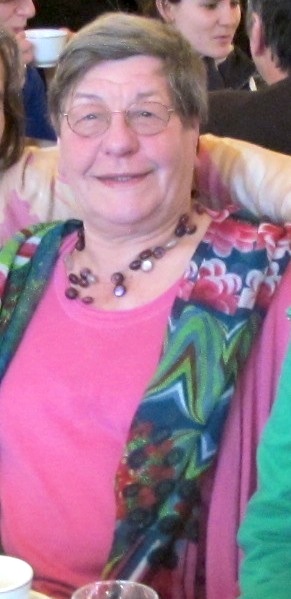
Ilse Kokula is a German sociologist, educator, author and lesbian activist in the field of lesbian life. She was awarded the Order of Merit of the Federal Republic of Germany.

There is a widespread and long-lasting myth alleging that homosexuals were numerous and prominent as a group in the Nazi Party or the identification of Nazism with homosexuality more generally. It has been promoted by various individuals and groups both before and after World War II, especially by left-wing Germans during the Nazi era and the Christian right in the United States more recently. Although some gay men joined the Nazi Party, there is no evidence that they were overrepresented. The Nazis harshly criticized homosexuality and severely persecuted gay men, even going as far as murdering them en masse. Therefore, historians regard the myth as having no merit.

The Eldorado was the name of multiple nightclubs and performance venues in Berlin before the Nazi Era and World War II. The name of the cabaret Eldorado has become an integral part of the popular iconography of what has come to be seen as the culture of the period in German history often referred to as the "Weimar Republic". Two of the five locations the club occupied in its history are known to have catered to a gay crowd, though the phrase gay bar, which could conjure up images of the type of bar that became common after World War II catering first and foremost to gay and lesbian clientele, does not accurately describe what an establishment like Eldorado to a certain extent was, and what similar venues still are to this day. Perhaps because in the present day it is no longer legally problematic in many places to be "suspected" of being gay, and likely due to the impact of internet on the entertainment industry in general, the popularity of establishments offering drag shows, etc. for the entertainment of a largely presumed to be heterosexual audience has somewhat waned. Nevertheless locales that offer ostensibly queer entertainment of some kind for the pleasure of heterosexuals, are very much still existent in the present. Eldorado was a gay cabaret in that along with gay, lesbian, bisexual, trans* patrons, a heterosexual-identifying audience would have been present as well. "Cross-dressing" was tolerated on the premises, though for the most part legally prohibited and/or sharply regulated in public at the time. This exception to everyday life attracted not only male patrons who wished to dress in the "clothing of the opposite sex", and their admirers, but also to no small extent women who wished to do the same, and their admirers. Wealthy lookers-on were encouraged to come and drink and watch as so-called "Zechenmacher". The practice was particularly common in so-called "Lesbian bars" or at so-called "Lesbian balls" in the neighborhood at the time and up the 1960s in places like the Nationalhof at nearby Bülowstraße 37. As women's incomes were on average much lower than men's then as now, male spectators with money to spend were explicitly welcome, and it was not uncommon that there were sex-workers present to offer their services. Eldorado also included what have come to be called drag shows as a regular part of the cabaret performances. There were numerous somewhat similar establishments to Eldorado during its day. The club has been described by writers, and artist and has been immortalized in paintings and photographs. However the eradication during the Nazi Period of any and all references to queer life in Germany was so thorough, that very little explicit public, or even archival reference to the clubs queer history remained by 1945. Criminalization made researching, speaking, or writing about queer realities a legal risk during the first decades following WWII, not only in Germany. That the cabaret Eldorado is remembered at all, is due in no small part to its central role in inspiring the novels of the Anglo-American author Christopher Isherwood and to the Broadway musical and moreover to the 1972 film Cabaret inspired by Isherwood's novels. At the same time historians, and activist of the Gay liberation movement, and of the ensuing LGBT rights movement began piecing back together was is now called queer history. Eldorado thereby became a prominent part of the telling of LGBTIQ+ histories.















